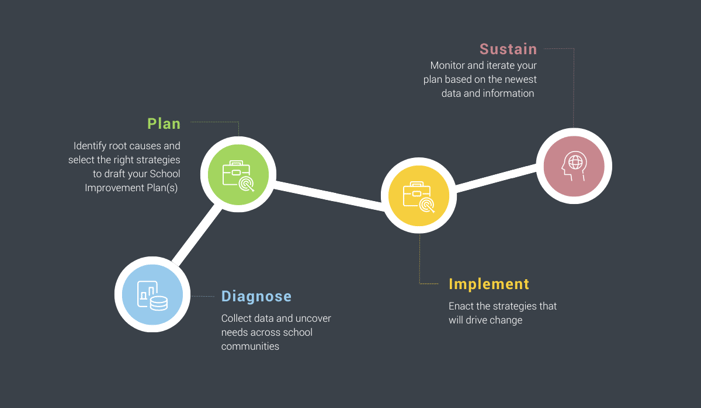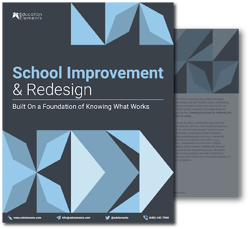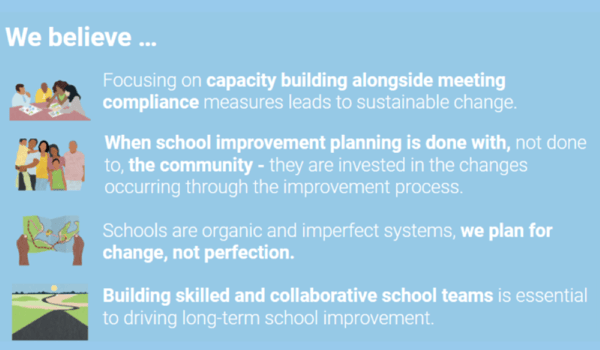As educators we hear the words “school improvement” a lot. Often the conversations about school improvement are centered around compliance jargon, what schools are doing wrong, or funding sources.
School improvement is a plan created to improve academic achievement and improve leadership, systems, and processes within a school.
School Improvement efforts often fail because the typical school improvement playbook does not account for the fact that schools are organic, imperfect, and subject to significant change during implementation. School improvement efforts are traditionally overly-complicated, compliance-driven, and based on outdated or inaccurate data. They often fail to address knowledge gaps and pay insufficient attention to adult learning culture.
At Education Elements, we believe that there are many things to focus on as part of school improvement - but ultimately they all focus on leadership and learning:
We believe that leadership can be found everywhere, not just with the school leader. School improvement efforts must engage all leaders to build systems and processes. With excellent leadership, we ensure that our work permeates every level, everyone feels connected, and that new norms are sustainable.
We believe that learning is not just for students, but also for adults. Learning new knowledge and skill requires space, scaffolding, and psychological safety and requires the use of high-quality materials and research-proven approaches. Learning requires consistent evaluation of the norms and systems in place.
Based on our experience working with over 1700 schools and 320 districts across the US., we have created this guide to provide a curated set of resources and literature about school improvement in K-12 settings, alongside many of the tools and resources that we have internally developed to help our district partners launch an effective school improvement plans.
You will learn:
Components of the School Improvement Process
Why every school needs a school improvement plan
Who should be on your school improvement team
Common goals for school improvement
Steps to include in a school improvement plan
Strategies for sustaining school improvement
You will find:
Tools, frameworks, guides, reports, videos, case studies and white papers that can help you in your school improvement journey, whether you're considering it, launching it, supporting it, sustaining it or scaling it in your school or district.
Information and ideas that are actionable and will shape your work moving forward.
The school improvement process is often variable due to state compliance requirements, but there are a few key components to each school improvement process:

These components are described in more detail below.
|
|
Diagnose: School data collection and analysis |
|
|
Plan: Create a School Improvement Plan |
|
|
Implement the School Improvement Plan |
|
|
Sustain: Monitor and iterate your plan |
 Our latest paper provides an in-depth look at how our process, purposefully designed for results, has helped hundreds of schools exit school improvement status. Our PLC School Improvement experts share evidence- and research-based strategies and processes based on decades of experience and results. Also discover success stories from multiple districts who have successfully exited school improvement.
Our latest paper provides an in-depth look at how our process, purposefully designed for results, has helped hundreds of schools exit school improvement status. Our PLC School Improvement experts share evidence- and research-based strategies and processes based on decades of experience and results. Also discover success stories from multiple districts who have successfully exited school improvement.

It is important to ensure that the team is inclusive, representative, and diverse, encompassing a range of perspectives and backgrounds. Collaboration, open communication, and shared decision-making should be encouraged among team members to foster a sense of ownership and commitment to the improvement plan.
Research behind school improvement efforts generally point to the presence of these core components:
Leadership Focused on Teaching & Learning - persistent, public focus at all levels of the educational system on improving the quality of instruction.
Guaranteed & Viable Curriculum - districts have identified essential content and skills necessary for all students to learn in specific courses and grade levels, and the guaranteed curriculum can be taught in the time available.
Challenging Goals & Effective Feedback - Challenging goals should be set at a level of difficulty so that the student has to put forth effort but are still attainable. Effective feedback is specific and personalized, transparent, addressable, timely, ongoing, content-rich, clear, purposeful, and compatible with students’ existing knowledge, while providing little threat to self-esteem. Effective feedback supports students to know where and how to improve, and it can support their motivation to invest effort in making improvements.
Parent & Community Involvement - All families have home environments to support children as students; School-to-home and home-to-school communications are effective; families help and support through volunteer efforts; families know to help students at home with homework and other curriculum-related activities, decisions, and planning; families are included in school decisions; resources and services from the community are integrated to strengthen school programs, family practices, and student learning and development.
Safe & Orderly Environment - Environment where teaching and learning are not distracted; disruptions are minimized; violence, drugs, bullying and fear are not present; students are not discriminated against; expectations for behavior are clearly communicated; and consequences for infractions are consistently and fairly applied.
Collegiality & Professionalism - Environment where teachers talk together about students; work together to develop curriculum; observe one another teach; teach one another; and teachers and administrators work together on educational issues.
Student Engagement & Motivation - Students’ active involvement in, and commitment to, academic and social activities in their school.
Sustained Professional Development - Process of learning that includes rigorous content for each learner and a continuous process for assessing learning needs.
Most state school improvement frameworks incorporate aspects of all these components, though they may use different language.
School improvement researchers that are often cited in state frameworks include John Kotter, Robert Marzano, Michael Fullan, and John Hattie.
Sources: AIR District and School Improvement Center, Wallace Center’s Leading School Improvement - What Research Says, Marzano School Improvement Resources, The Wallace Foundation Practice of Learning-focused Leadership, John Hattie - Effective Feedback, Barry Zimmerman & Goal Setting, Epstein - Family Involvement Framework, Roland Barth- Faculty Collegiality, Learning Forward Standards of Professional Learning
Klein Independent School District (Klein ISD) in the suburbs of Houston, Texas serves more than 52,000 students across 51 schools. In 2020, Education Elements partnered with individual campuses awarded Transformation Grants to build the capacity of campus leaders, especially specialists, and support each campus to achieve their specific goals as laid out in their Campus Improvement Plan (CIP) and Effective Schools Framework (ESF) plan. Our focus areas for the work were training specialists to deepen their understanding of personalized learning, lead retrospectives to reflect on personalized learning implementation, and build capacity to personalize professional development. Klein ISD believed Education Elements was the right partner for this work given the team’s deep experience in change management, capacity building, school transformation, and leadership development. We provided an intensive summer of customized, consulting support for intermediate and elementary campuses, which included:
By the end of the project, each school had an action plan and project roadmap for personalized learning and CIP implementation, project management process for specialists to use with teachers, and a Personalized Learning Tenet Toolkit. In the 2021-2022 school year, the elementary campus we supported moved to an overall “B” rating, with an “A” in school progress.
Education Elements has worked with a number of LEAs in Pennsylvania to support school improvement efforts across the state. We have partnered with the statewide school improvement team to support the School Improvement Facilitators (SIFs) who guide the teams in CSI schools through the creation and implementation of improvement plans. Our work with the SIFs focused on the responsive leadership practices and approaches to facilitation that would empower leaders in each school to identify and act on the highest leverage moves for improvement.
In addition to the support for School Improvement Facilitators, we have worked more directly to support districts and schools, coaching principals and instructional leaders in designated schools across the state, and partnering with Harrisburg School District leadership and school improvement teams from schools designated for Comprehensive School Improvement to develop and implement their school improvement plans, in alignment with Pennsylvania’s Cycle of Improvement. The planning process brought together teams from different schools to engage with the steps needed to complete a comprehensive needs assessment, root cause analysis, goal setting, and action planning. Implementation support for the school improvement teams is structured to create a more responsive approach to school improvement plan implementation, building capacity within the school teams to effectively manage change on their campuses, by engaging in intentional review and reflection at a regular cadence, and making strategic adjustments to the plan to ensure better outcomes for students in Harrisburg.
In late 2021, Education Elements began its partnership with the Hawai‘i Department of Education’s School Transformation Branch to provide school improvement services to CSI (Comprehensive Support and Improvement) and TSI (Targeted Support and Improvement) identified schools through the inaugural Data Culture Cohort. Through this four-month experience designed for individual schools as well as complex areas (subdivisions of the statewide district), the Education Elements team facilitated a human-centered design process to enable participants to more effectively and responsively utilize data to make decisions that support elevating student outcomes. As a result of the cohort experience, teams were able to walk away with actionable prototypes to solve for a particular problem of practice in their respective context, which served as a stepping stone on their school improvement journeys, and would be integrated into their academic plans for the following year.
After repeating the cohort experience for a second year and strengthening relationships with many school and complex area leaders throughout the state, Education Elements was also able to expand its offerings to provide more individualized school improvement services — primarily by conducting comprehensive needs assessments (CNAs), co-developing 30-60-90 day improvement plans, and serving as an implementation and accountability partner to carry out actions articulated in those plans.
To date, we have worked with 20 schools and complex areas as partners in school improvement.
While we have proven our value as “critical friends” for leaders throughout these compliance-focused components of school improvement, Education Elements has also emphasized the importance of, and identified opportunities for developing the capacity of leadership teams with responsive leadership practices.
From decision-making to planning, sharing information, and managing roles, these transferable skills have helped leaders across the state strengthen their ability to confront complexity and manage change throughout the school improvement process.
Improved schools demonstrate components proven by the research and identified by the state’s framework, and likely include:
High expectations for staff and students
Focus on instruction
Aligned standards, curriculum, and assessments
Targeted professional development
Distributed leadership and clearly defined roles and responsibilities
Strategic allocation of resources
Sustain improvement efforts
Measuring success goes beyond academic metrics and should also consider the overall school climate, culture, and the fulfillment of the broader goals of the improvement plan.

We believe that involving students, parents, families, and the community into the process of school improvement is not only important but crucial to create a sustained school improvement. One common way to involve these constituents is through high-impact surveys that give each school and district targeted data for moving forward. Take advantage of our easy-to-use surveys that contain research based best practices. More specifically, we help you to monitor information across a variety of critical areas: leadership, curriculum, instructional practices, student social/emotional health and family connections.
We recommend surveying the community on a likert scale from strongly agree to strongly disagree.
Some questions we ask students include:
Some questions we ask families include:

We respond to requests immediately, so we’ll get back to you super fast to set up a time to chat.